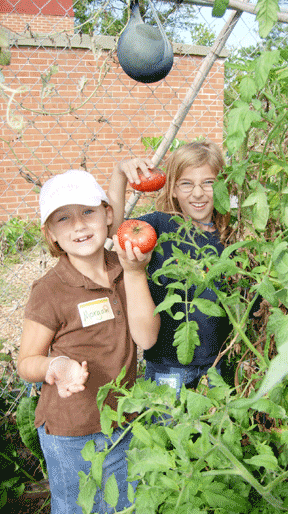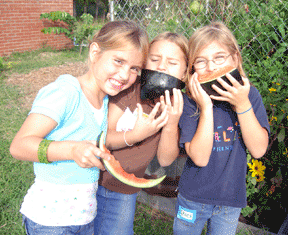Harvesting Lessons of Thanksgiving’s Roots
A new generation learns how to put food on the table
by Carrie Madren
 |
Morgan Stueckler and Grace Iannicelli show off their garden’s organic tomatoes.
|
Circling the garden with outstretched arms, gardening protégés chant a prayer over their work:
Sun, soil, water and air
In everything we eat
In everything we wear
Taking giant sideways steps, eight girls and two women circumnavigated a tiny fenced-in garden at Shady Side Elementary School. This is the Wednesday afternoon ritual of a new generation cultivating skill in the ancient arts of gardening.
Passing on the traditions each week are Jeannie ‘Green Jeans’ Grimes of Two Hollies Farm and Margaret ‘Miss Marigold’ Barker, who run Shady Side Elementary’s garden club. Kids in the club get their hands dirty while learning the joys and woes of gardening by raising beans, sugar-baby watermelon, tomatoes, a bevy of herbs and more.
These kids are returning to Thanksgiving’s roots, learning how to set their tables with nature’s bounty.
The elementary-aged children from kindergarteners to fifth-graders in the gardening club have learned that food doesn’t begin in the grocery store. They’re also grasping environmental synergy of soil, plants, air, bugs and birds.
“This is agricultural education,” says Barker, “so kids don’t take food for granted.” As our future growers learn green lessons in horticulture, they also discover the tiny joys and surprises that are the fun of gardening.
This year, the green project won a 2007 Youth Garden Grant from the National Gardening Association and Home Depot — an honor bestowed on only two other Maryland schools.
Planting Seeds
One fall afternoon at the garden — dubbed the Cool HAT (Healthy And Tasty) Food Garden — Barker shows her young charges a black swallowtail caterpillar munching away on a now leafless parsley sprig.
“Isn’t it amazing that it knows this is a parsley plant?” she exclaims as kids swarm to her side for a better view of this specimen. They ponder only a moment before donning gloves and frantically digging in for five minutes of Wacky Weeding. They try to fill up a yellow tub with weeds under the time limit, scrambling to meet their goal.
“Fifteen more seconds,” Barker warns. Kids shriek with glee and plead for another 10 seconds to try to fill the tub. One young green-thumb asks what is a weed?
“The definition of a weed is a plant growing where you don’t want it to,” says Grimes, who helped design the club’s two gardens, contained in chain-link dog kennels.
The bigger of the two is an Eden filled with plants of all shapes and sizes, a green globe of a sugar-baby hanging in netting from the top of the fence and towering tomato plants. The six-foot-high fence keeps deer and other critters out; its outer perimeter is herbs and other low plants.
The second, newer garden is a three sisters garden, where the club has planted together corn, beans and squash just as Native Americans did hundreds of years ago. Beans use the corn as poles while the squash shades the soil and puts nitrogen in the soil for the corn.
“It’s a nutrition concept,” says Grimes, who passes along the food lesson to her club members. “Everything you need to make a complete protein. Eat these three foods together to stay healthy.”
Grimes and Barker conceived the garden when shopping at Turn Around Consignment shop.
“It’s quite the local hub,” Grimes says. “We were both shopping, and I overheard her talking to the sales clerk. Then we started chatting.” It turns out both women had dreamed of starting a garden for school children. Their dream came true in the spring of 2006, when they covered the garden site with cardboard to kill underlying weeds and grass. Then came soil, fencing and plants.
Much of the tiny farm — plus tools and gloves — were donated by nearby businesses, including Wheelers Hardware and Home Depot. Grimes and Barker each put in some 10 to 15 volunteer hours every week.
Flyers went up around the school — new garden club open to everyone — and a dozen youngsters showed up for the first meeting. Grimes told them they’d be growing a pizza garden: tomatoes, oregano and basil. One young gardener asked how they were going to grow the cheese.
 |
Shady Side Elementary students Alyssa Osborne-Sukalo, Morgan Stueckler and Grace Iannicelli sample the sugar-baby watermelons from their harvest.
|
School Salad
There’s no mozzarella sprouting in this garden, but the club raises — organically, of course — herbs, vegetables and a few historical plants.
Cardoon, a celery-like plant eaten in colonial times, lends botanical history. A native honeysuckle plant helps teach kids about the difference between native and invasive species.
Seasoning the garden are oregano, lemon thyme, rosemary, chocolate mint and more. Grimes ordered a special cooking variety of parsley from Naples, Italy.
Kids get to try white eggplants and blue Lake Blue beans from a colorful garden that yields chard, several varieties of tomatoes and sweet sugar baby melons. Zinnias attract butterflies. Okra was planted at the request of a fifth-grader who had moved from New Orleans after Hurricane Katrina.
Grimes and Barker encourage kids to try new foods, but the rule is that if you don’t like it, say nothing and toss it in the compost: No complaining.
There’s also Scaredy Cat — a low, green round-leafed plant — that smells like a skunk. Grimes had to get special papers to bring it over the border from Canada.
“The kids had an experiment where they planted chard outside the fence, but the deer ate it down to nubbins,” Grimes said. When they planted Scaredy Cat around it, the chard came back: The leaves’ smell kept nearby chard and tomatoes safe.
“The kids call it Mr. Stinky,” Grimes says.
Green Thumb Lessons
Grimes and Barker teach their green-thumbed charges to delight in surprises in the garden: a hidden melon growing in the mums, a praying mantis or a blooming plant.
Summer yielded plant and animal life in abundance.
“The kids came back all summer to look after the garden,” says school principal Deborah Short. Each week brought new wildlife and changes to the garden
In early October, the surprise was a black swallowtail caterpillar.
Late last fall, there was a surprise of a different kind.
“We had a killer frost last year,” said Barker. “We didn’t tell the kids beforehand, but we told them something was different. All of the sudden, they saw that the garden was brown.” The children gasped; some shrieked at the sight of the change. Others asked if Barker and Grimes were going to fix the garden.
Frost is a life lesson gardeners learn, but life goes on.
With autumn here again, there are seeds for the young gardeners to harvest for next year’s crops.
The winter plan is to mulch over the soil. The gardeners may grow seeds of hardy greens like kale and mustard spinach under lights in the art room.
The garden teaches year-long lessons. Grimes and Barker teach songs, chants and dances to help kids understand how water moves in clay, silt and sandy soils. Other lessons teach kids about daylight: where the sun comes up and where it sets.
“I like harvesting the food, and sometimes Green Jeans lets us take it home to cook,” says eight-year-old Morgan Stueckler, referring to Grimes by her garden club nickname.
Come Thanksgiving, these young gardeners will take their lesson to the table, for they have learned why we feast.


